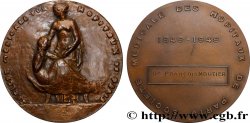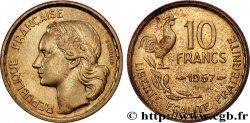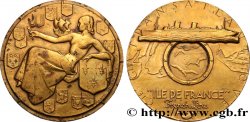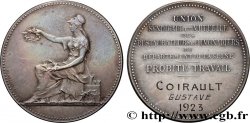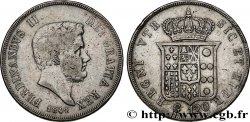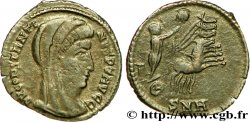fme_659169 - QUARTA REPUBBLICA FRANCESE Médaille, Compagnie Transatlantique, Île-de-France
70.00 €
Quantità
Aggiungi al carrello

Tipo : Médaille, Compagnie Transatlantique, Île-de-France
Data: 1949
Nome della officina / città: 75 - Paris
Metallo : bronzo
Diametro : 53,5 mm
Asse di coniazione : 12 h.
Incisore RENARD Marcel (1893-1974)
Peso : 78,30 g.
Orlo : lisse + corne BRONZE
Marchio : corne BRONZE
Commenti sullo stato di conservazione:
Exemplaire ayant été nettoyé présentant plusieurs coups et rayures, en particulier sur la tranche
Diritto
Titolatura diritto : ANÉPIGRAPHE.
Descrittivo diritto : Allégorie féminine, torse nu, accoudée sur un écusson aux trois fleurs de lys ; 12 autres petits écu et la nef de Paris dans le champ. Signé : MARCEL RENARD 1949.
Rovescio
Titolatura rovescio : CIE GLE TRANSATLANTIQUE // “ILE DE FRANCE” / FRENCH LINE.
Descrittivo rovescio : Le navire “Ile de France”, sur un fond de carte marine, avec au centre un hublot donnant à voir des mouettes.
Commento
L’Île-de-France est un paquebot construit en 1927 par les Chantiers de Penhoët de Saint-Nazaire pour la Compagnie générale transatlantique. Il est détruit à Osaka en 1959 après avoir été utilisé pour le tournage du film Panique à bord.
Son histoire est marquée par plusieurs événements dont sa participation à la Seconde Guerre mondiale et deux sauvetages dans l’océan Atlantique.
Marcel Renard, né à Lyon le 5 août 1893, mort à Paris le 15 mars 1974, est un sculpteur et graveur-médailleur français. D'abord élève de son père, Marcel Renard entre à l’École des beaux-arts de Lyon dans les ateliers d’Aubert et de Ploquin, puis il est admis à l’École des beaux-arts de Paris dans les ateliers de Rost et de Boucher. Il obtient le second grand prix de Rome de gravure en médailles, et une médaille d’or à l’Exposition des arts décoratifs de 1925. Condisciple de Gimond, de Salendre, de Bertola et de Penin, il expose au Salon des artistes français ainsi qu’au Salon des artistes décorateurs. Marcel Renard se fixe à Paris en 1920 et travaille avec Roux-Spitz sur ses chantiers lyonnais, qu’il s’agisse de la Villa Weitz (1923), du restaurant Berrier et Millet (1924-1928, avec Janniot, détruit) ou encore de la sépulture Vetter au cimetière de la Croix-Rousse à Lyon (1924). Ses œuvres sont conservées, entre autres, au musée des beaux-arts de Lyon, Victoria & Albert Museum, Londres, Grande Bretagne, Musée du Design de Gand, Belgique et Musée Rolf de Marès, Stockholm, Suède..
The Île-de-France is an ocean liner built in 1927 by the Penhoët shipyards in Saint-Nazaire for the Compagnie Générale Transatlantique. It was destroyed in Osaka in 1959 after being used for the filming of the movie Panic on Board.
Its history is marked by several events including its participation in the Second World War and two rescues in the Atlantic Ocean..
Marcel Renard, born in Lyon on August 5, 1893, died in Paris on March 15, 1974, is a French sculptor and engraver-medalist. Initially a student of his father, Marcel Renard entered the École des Beaux-Arts in Lyon in the studios of Aubert and Ploquin, then he was admitted to the École des Beaux-Arts in Paris in the studios of Rost and Boucher.. He won the second Grand Prix de Rome for medal engraving and a gold medal at the 1925 Decorative Arts Exhibition.. A classmate of Gimond, Salendre, Bertola and Penin, he exhibited at the Salon of French Artists as well as at the Salon of Decorative Artists.. Marcel Renard settled in Paris in 1920 and worked with Roux-Spitz on his Lyon projects, whether it was the Villa Weitz (1923), the Berrier et Millet restaurant (1924-1928, with Janniot, destroyed) or the Vetter tomb in the Croix-Rousse cemetery in Lyon (1924).. His works are held, among others, at the Museum of Fine Arts in Lyon, Victoria & Albert Museum, London, Great Britain, Design Museum in Ghent, Belgium and Rolf de Marès Museum, Stockholm, Sweden..
Son histoire est marquée par plusieurs événements dont sa participation à la Seconde Guerre mondiale et deux sauvetages dans l’océan Atlantique.
Marcel Renard, né à Lyon le 5 août 1893, mort à Paris le 15 mars 1974, est un sculpteur et graveur-médailleur français. D'abord élève de son père, Marcel Renard entre à l’École des beaux-arts de Lyon dans les ateliers d’Aubert et de Ploquin, puis il est admis à l’École des beaux-arts de Paris dans les ateliers de Rost et de Boucher. Il obtient le second grand prix de Rome de gravure en médailles, et une médaille d’or à l’Exposition des arts décoratifs de 1925. Condisciple de Gimond, de Salendre, de Bertola et de Penin, il expose au Salon des artistes français ainsi qu’au Salon des artistes décorateurs. Marcel Renard se fixe à Paris en 1920 et travaille avec Roux-Spitz sur ses chantiers lyonnais, qu’il s’agisse de la Villa Weitz (1923), du restaurant Berrier et Millet (1924-1928, avec Janniot, détruit) ou encore de la sépulture Vetter au cimetière de la Croix-Rousse à Lyon (1924). Ses œuvres sont conservées, entre autres, au musée des beaux-arts de Lyon, Victoria & Albert Museum, Londres, Grande Bretagne, Musée du Design de Gand, Belgique et Musée Rolf de Marès, Stockholm, Suède..
The Île-de-France is an ocean liner built in 1927 by the Penhoët shipyards in Saint-Nazaire for the Compagnie Générale Transatlantique. It was destroyed in Osaka in 1959 after being used for the filming of the movie Panic on Board.
Its history is marked by several events including its participation in the Second World War and two rescues in the Atlantic Ocean..
Marcel Renard, born in Lyon on August 5, 1893, died in Paris on March 15, 1974, is a French sculptor and engraver-medalist. Initially a student of his father, Marcel Renard entered the École des Beaux-Arts in Lyon in the studios of Aubert and Ploquin, then he was admitted to the École des Beaux-Arts in Paris in the studios of Rost and Boucher.. He won the second Grand Prix de Rome for medal engraving and a gold medal at the 1925 Decorative Arts Exhibition.. A classmate of Gimond, Salendre, Bertola and Penin, he exhibited at the Salon of French Artists as well as at the Salon of Decorative Artists.. Marcel Renard settled in Paris in 1920 and worked with Roux-Spitz on his Lyon projects, whether it was the Villa Weitz (1923), the Berrier et Millet restaurant (1924-1928, with Janniot, destroyed) or the Vetter tomb in the Croix-Rousse cemetery in Lyon (1924).. His works are held, among others, at the Museum of Fine Arts in Lyon, Victoria & Albert Museum, London, Great Britain, Design Museum in Ghent, Belgium and Rolf de Marès Museum, Stockholm, Sweden..








 Segnalare un errore
Segnalare un errore Stampate la pagina
Stampate la pagina Condividi mia selezione
Condividi mia selezione Fai una domanda
Fai una domanda Consegnare / vendere
Consegnare / vendere
 Descrittivo
Descrittivo


